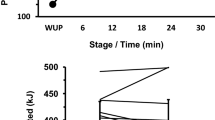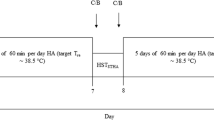Abstract
Aim
To reevaluate the previous hypothesis that greater reductions in self-paced exercise intensity in the heat are mediated by early differences in the rate of body heat storage (S).
Methods
Eight trained volunteers cycled in 19 °C/1.8 kPa (COOL), 25 °C/1.2 kPa (NORM), and 34 °C/1.6 kPa (HOT), while maintaining an RPE of 16. Potential differences in S following the onset of exercise were assessed by comparing rates of esophageal temperature change (ΔT es/Δt); and estimated S values using a traditional two-compartment thermometric model (S therm) of changes in rectal (T re) and skin (T sk) temperature, and partitional calorimetry (S cal).
Results
After 15 min of exercise, workload decreased more in HOT vs. COOL (P = 0.03), resulting in a shorter time (HOT: 40.7 ± 14.9 min; COOL: 53.5 ± 18.7 min; P = 0.04) to 70 % of initial workload. However, there were no preceding differences in ΔT es/Δt between conditions (P = 0.18). S therm values were different between HOT and COOL during the first 5 min of exercise (P < 0.05), primarily due to negative S therm values (−32 ± 15 kJ min−1) in COOL, which according to partitional calorimetric measurements, required improbably high (~56 kJ min−1) rates of evaporation when no sweating on the back and thigh was observed until after 7.6 ± 1.5 min and 4.8 ± 1.7 min of exercise, respectively. S cal values in the first 5 min of exercise confirmed S was actually positive in COOL (+21 ± 8 kJ min−1) and not negative. Different S therm values following the onset of exercise at different environmental temperatures are simply due to transient differences in the rate of change in T sk.
Conclusion
Reductions in self-paced exercise intensity in the heat are not mediated by early differences in S following the onset of exercise.






Similar content being viewed by others
Abbreviations
- A r/A D :
-
Effective radiant surface area (ND)
- BF:
-
Biceps femoris
- A D :
-
Body surface area (m2)
- C :
-
Convective heat exchange (W m−2)
- C res :
-
Convective heat exchange via respiration (W m−2)
- E sk :
-
Evaporative heat loss from the skin (W m−2)
- E res :
-
Evaporative heat loss via respiration (W m−2)
- E C :
-
Caloric equivalent of carbohydrates (kJ LO−2)
- E F :
-
Caloric equivalent of lipids (kJ LO−2)
- EMG:
-
Electromyography (% of initial EMG)
- ε :
-
Area-weighted emissivity of the skin (ND)
- f cl :
-
Area-weighted clothing factor (ND)
- GM:
-
Gluteus maximus
- h :
-
Combined heat transfer coefficient (W m−2 °C−1)
- h c :
-
Convective heat transfer coefficient (W m−2 °C−1)
- h r :
-
Radiative heat transfer coefficient (W m−2 °C−1)
- H prod :
-
Rate of metabolic heat production (W m−2)
- iEMG:
-
Integrated electromyography (% of initial iEMG)
- LG:
-
Lateral gastrocnemius
- LSRback :
-
Local sweat rate on the lower back (mg cm−2 min−1)
- LSRthigh :
-
Local sweat rate on the thigh (mg cm−2 min−1)
- M :
-
Metabolic energy expenditure (W m−2)
- PAR-Q:
-
Physical Activity Readiness Questionnaire
- P a :
-
Ambient water vapor pressure (kPa)
- R :
-
Radiant Heat exchange (W m−2)
- R cl :
-
Thermal resistance of clothing (m2 °C W−1)
- RER:
-
Respiratory exchange ratio (ND)
- RPE:
-
Rating of perceived exertion
- S :
-
Rate of body heat storage (kJ min−1)
- S cal :
-
Rate of body heat storage measured with partitional calorimetry (kJ min−1)
- S therm :
-
Rate of body heat storage estimated with a traditional 2-compartment thermometry model (kJ min−1)
- σ :
-
Stefan-Boltzmann constant (5.67 × 10−8W m−2 °C−4)
- T a :
-
Ambient air temperature (°C)
- ΔT b :
-
Change in mean body temperature (°C)
- T cl :
-
Temperature of the clothing (°C)
- T es :
-
Esophageal temperature (°C)
- ΔT es/Δt :
-
Rate of oesophageal temperature change (°C min−1)
- T o :
-
Operative temperature (°C)
- T r :
-
Mean radiant temperature (°C)
- T re :
-
Rectal temperature (°C)
- T sk :
-
Mean skin temperature (°C)
- VO2peak :
-
Peak rate of oxygen consumption (L min−1)
- VO2 :
-
Rate of oxygen consumption (L min−1)
- v :
-
Air velocity (m s−1)
- VL:
-
Vastus lateralis
- W :
-
Rate of external work (W m−2)
- W peak :
-
Peak rate of external work (W)
References
Blight J (1957) The relationship between the temperature in the rectum and of the blood in the bicarotid trunk of the calf during exposure to heat stress. J Physiol 136:393–403
Borg GA (1982) Psychophysical bases of perceived exertion. Med Sci Sports Exerc 14:377–381
Cooper KE, Kenyon JR (1957) A comparison of temperatures measured in the rectum, œsophagus, and on the surface of the aorta during hypothermia in man. Br J Surg 44:616–619
Cotter JD, Taylor NA (2005) The distribution of cutaneous sudomotor and alliesthesial thermosensitivity in mildly heat-stressed humans: an open-loop approach. J Physiol 565:335–345
Crewe H, Tucker R, Noakes T (2008) The rate of increase in rating of perceived exertion predicts the duration of exercise to fatigue at a fixed power output in different environmental conditions. Euro J Appl Physiol 103:569–577
CSEP (1996) Canadian Society for Exercise Physiology: certified fitness appraiser resource manual. CSEP, Ottawa
DuBois D, Dubois E (1916) A formula to estimate surface area if height and weight are known. Arch Intern Med 17:863
Ely BR, Ely MR, Cheuvront SN, Kenefick RW, DeGroot DW, Montain SJ (2009) Evidence against a 40°C core temperature threshold for fatigue in humans. J Appl Physiol 107:1519–1525
Ericson MO (1986) On the biomechanics of cycling. A study of joint and muscle load during exercise on the bicycle ergometer. Scand J Rehabil Med Suppl 16:1–43
Fanger PO (1970) Thermal comfort. Danish Technical Press, Copenhagen
Flouris AD (2011) Functional architecture of behavioural thermoregulation. Eur J Appl Physiol 111:1–8
Gephart FC, DuBois EF (1915) Fourth paper the determination of the basal metabolism of normal men and the effect of food. Arch Intern Med (Chic) 15:835–867
González-Alonso J, Mora-Rodríguez R, Coyle EF (2000) Stroke volume during exercise: interaction of environment and hydration. Am J Physiol Heart Circ Physiol 278:H321–H330
Horstman DH, Horvath SM (1972) Cardiovascular and temperature regulatory changes during progressive dehydration and euhydration. J Appl Physiol 33:446–450
Jay O, Kenny GP (2009) Current evidence does not support an anticipatory regulation of exercise intensity mediated by rate of body heat storage. J Appl Physiol 107:630–631
Jay O, Gariépy LM, Reardon FD, Webb P, Ducharme MB, Ramsay T, Kenny GP (2007) A three-compartment thermometry model for the improved estimation of changes in body heat content. Am J Physiol Regul Integr Comp Physiol 292:R167–R175
Mekjavic IB, Rempel ME (1990) Determination of esophageal probe insertion length based on standing and sitting height. J Appl Physiol 69:376–379
Molnar GW, Read RC (1974) Studies during open-heart surgery on the special characteristics of rectal temperature. J Appl Physiol 36:333–336
Nishi Y, Gagge AP (1970) Direct evaluation of convective heat transfer coefficient by naphthalene sublimation. J Appl Physiol 29:830–838
Nybo L, Nielsen B (2001) Hyperthermia and central fatigue during prolonged exercise in humans. J Appl Physiol 91:1055–1060
Ramanathan NL (1964) A new weighting system for mean surface temperature of the human body. J Appl Physiol 19:531–533
Schlader ZJ, Simmons SE, Stannard SR, Mündel T (2011a) The independent roles of temperature and thermal perception in the control of human thermoregulatory behavior. Physiol Behav 103:217–224
Schlader ZJ, Simmons SE, Stannard SR, Mündel T (2011b) Skin temperature as a thermal controller of exercise intensity. Eur J Appl Physiol 111:1631–1639
Schlader ZJ, Stannard SR, Mündel T (2011c) Evidence for thermoregulatory behavior during self-paced exercise in the heat. J Therm Biol 36:390–396
Shiraki K, Konda N, Sagawa S (1986) Esophageal and tympanic temperature responses to core blood temperature changes during hyperthermia. J Appl Physiol 61:98–102
Snellen JW (2000) An improved estimation of mean body temperature using combined direct calorimetry and thermometry. Eur J Appl Physiol 82:188–196
Stolwijk JA, Hardy JD (1966) Partitional calorimetric studies of responses of man to thermal transients. J Appl Physiol 21:967–977
Tucker R, Rauch L, Harley YXR, Noakes TD (2004) Impaired exercise performance in the heat is associated with an anticipatory reduction in skeletal muscle recruitment. Pflugers Arch Eur J Physiol 448:422–430
Tucker R, Marle T, Lambert EV, Noakes TD (2006) The rate of heat storage mediates an anticipatory reduction in exercise intensity during cycling at a fixed rating of perceived exertion. J Physiol 574:905–915
Vallerand A (1992) How should body heat storage be determined in humans: by thermometry or calorimetry? Eur J Appl Physiol O 65:286–294
Acknowledgments
The authors thank the volunteers for their participation and effort. This research was supported by a Discovery Grant from the Natural Sciences and Engineering Research Council (NSERC) of Canada (#386143-2010, held by O. Jay). Funding for the metabolic cart and dew point sensor were provided by a Canadian Foundation for Innovation (CFI) Infrastructure grant (co-applicant: O. Jay). N.M. Ravanelli was supported by a University of Ottawa Faculty of Health Sciences Research Bursary. M.N. Cramer is supported by a Postgraduate Scholarship (doctoral) from NSERC and an Excellence Scholarship from the University of Ottawa. Y. Molgat-Seon was supported by a University of Ottawa Master’s Scholarship. A.N. Carlsen is supported by NSERC and the University of Ottawa, Faculty of Health Sciences.
Conflict of interest
The authors report no competing interests, financial or otherwise.
Author information
Authors and Affiliations
Corresponding author
Additional information
Communicated by Narihiko Kondo.
Rights and permissions
About this article
Cite this article
Ravanelli, N.M., Cramer, M.N., Molgat-Seon, Y. et al. Do greater rates of body heat storage precede the accelerated reduction of self-paced exercise intensity in the heat?. Eur J Appl Physiol 114, 2399–2410 (2014). https://doi.org/10.1007/s00421-014-2958-y
Received:
Accepted:
Published:
Issue Date:
DOI: https://doi.org/10.1007/s00421-014-2958-y




